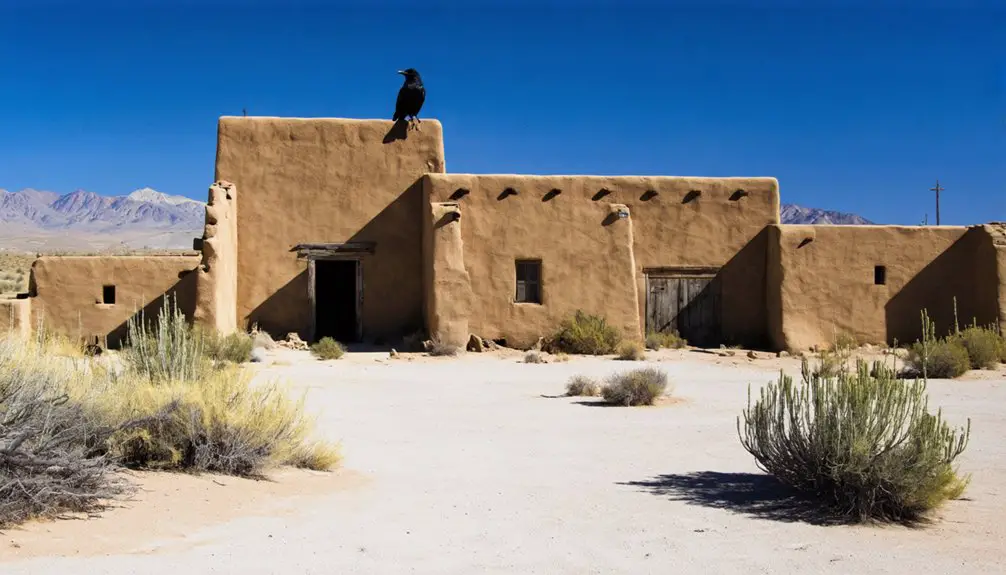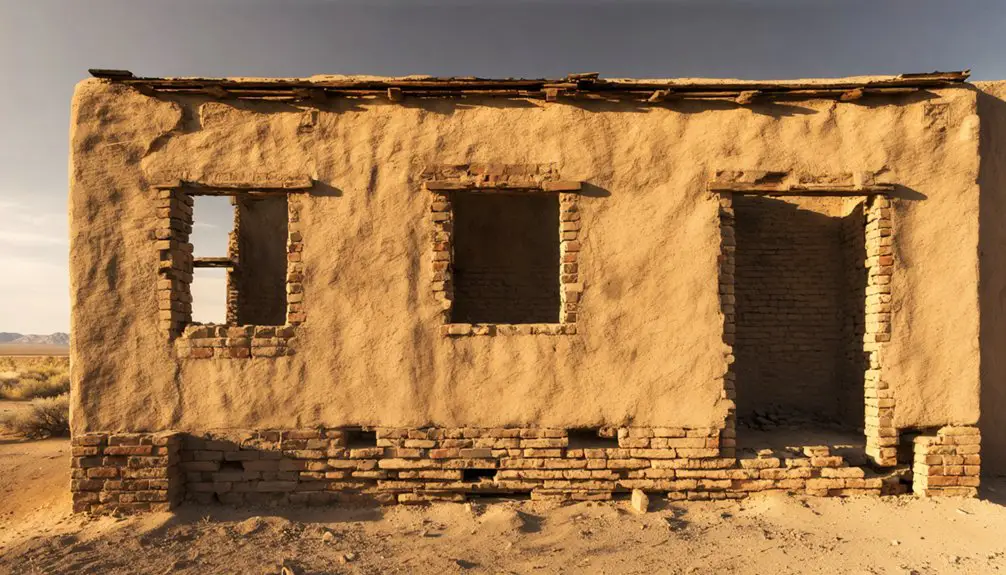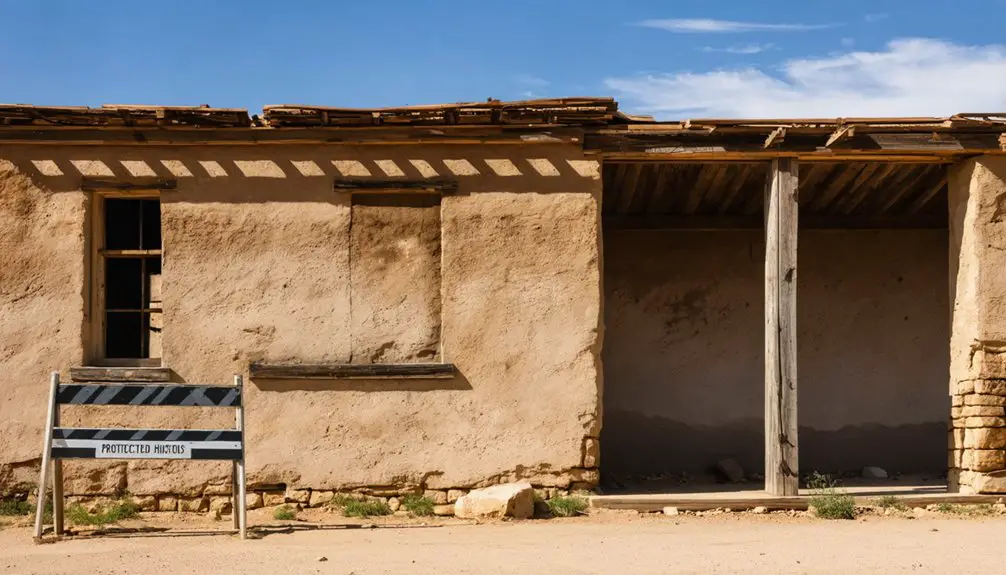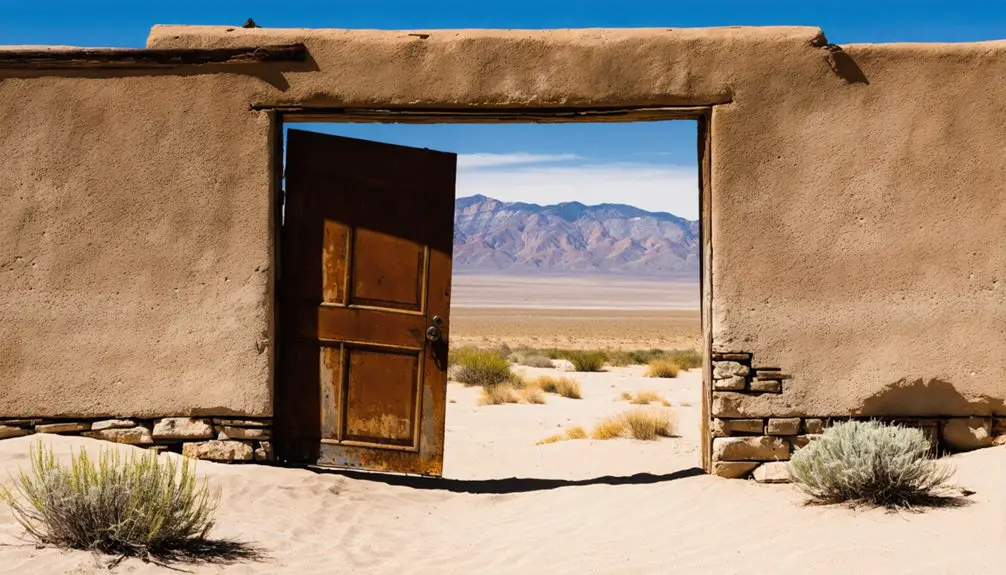You’ll find Fort Churchill’s adobe ruins sprawled across 13 acres along Nevada’s Carson River, where it once protected pioneer settlers and Pony Express routes in 1860. Today, it’s Nevada’s most extensive military ruin, featuring nearly two dozen deteriorating structures arranged around a central parade ground. The Civilian Conservation Corps stabilized these historic remains in the 1930s, and they’re now preserved as a National Historic Landmark. Each crumbling wall holds stories of frontier life, military strategy, and cultural conflict.
Key Takeaways
- Fort Churchill was a military outpost established in 1860 and abandoned by 1869, becoming one of Nevada’s prominent ghost towns.
- Nearly two dozen adobe ruins remain today, centered around a 13-acre parade ground within the Fort Churchill State Historic Park.
- The fort was sold for just $750 at auction after its abandonment, with locals salvaging materials from its structures.
- The Civilian Conservation Corps preserved the adobe ruins in the 1930s, preventing complete deterioration of this historic site.
- Visitors can now explore the preserved ruins and educational exhibits that showcase the fort’s military and cultural significance.
The Birth of a Desert Fortress
When violent conflicts erupted between Native American tribes and settlers in 1860, the U.S. Army commissioned Fort Churchill to protect settlers and secure the crucial Pony Express mail route.
You’ll find this historic stronghold perched strategically on the northern banks of the Carson River, where it once served as a defensive bulwark during the Pyramid Lake War.
The fort construction began on July 20, 1860, showcasing impressive military architecture that covered 13 acres.
Workers built nearly two dozen adobe buildings atop stone foundations, arranging them around a central parade ground.
This desert fortress, named after Inspector General Sylvester Churchill, represented one of Nevada’s first major military installations.
The headquarters building, which housed the Pony Express station, still stands today as a monument to the fort’s strategic importance in securing America’s western frontier.
At its peak, the fort maintained a garrison of up to 300 soldiers who helped stabilize the region.
After its abandonment in 1869, the fort was sold for $750 at auction when the state of Nevada declined to take ownership.
Military Life on the Frontier
Life at Fort Churchill revolved around a rigorous military routine that shaped the daily existence of its 337 men and 12 women.
You’ll find that soldier camaraderie helped troops endure the harsh conditions of desert life, where scorching heat and water scarcity tested their resilience daily.
Stationed troops divided their time between critical duties: protecting California-bound emigrants, guarding Pony Express routes, and maintaining peace with local Paiute tribes.
Inside the fort’s adobe walls, you’d have witnessed soldiers patrolling, managing supplies, and receiving medical care at the on-site hospital.
The fort’s design, featuring 58 buildings arranged in a hollow square, provided essential shelter from the unforgiving environment.
While recreational activities were limited, the small community of soldiers and civilians created a support system that helped them endure frontier isolation.
The fort served as a crucial Nevada Military District depot, storing and distributing essential supplies throughout the region.
The troops often spent their free time engaged in card games and drinking, seeking entertainment to cope with their remote posting.
Strategic Importance During the Civil War
During the Civil War, you’ll find Fort Churchill served as a critical Union supply hub and recruitment center, housing up to 600 soldiers who maintained Federal control over Nevada’s silver-rich territory.
The fort was auctioned for $750 to Samuel Buckland after its abandonment in 1869.
You can trace how the fort’s strategic position allowed troops to protect crucial communication routes, including the Pony Express and telegraph lines that connected the East Coast to California.
The fort’s role in securing these transportation corridors proved indispensable for moving Union supplies, coordinating military responses, and preventing Confederate sympathizers from disrupting communication networks in the American West. The adobe brick structures provided essential shelter for nearly 300 soldiers stationed at this remote desert outpost.
Union Supply Line Hub
As the American Civil War intensified, Fort Churchill emerged as an essential Union supply hub, serving both as a major depot and strategic command center in the Nevada Territory.
You’ll find evidence of the fort’s extensive logistical challenges in its network of 58 buildings, constructed at a cost of $179,000 using materials hauled by mule teams from the Sierra Nevada and West Coast.
The fort’s military logistics operations proved critical to Union control of the West, with up to 600 troops managing the storage and distribution of important supplies, arms, and provisions.
You can imagine the bustling activity as soldiers coordinated supplies while protecting communication lines, arresting Southern sympathizers, and maintaining order in this remote but strategically significant outpost of Federal power.
The fort’s garrison of 200 U.S. Army soldiers maintained a constant presence throughout its operational years, though many struggled with the isolation of desert life.
Defensive Position Out West
Situated along the Carson River’s significant transportation corridor, Fort Churchill commanded exceptional strategic importance during the Civil War as a defensive stronghold in the American West.
The fort’s military strategy centered on protecting essential communication lines, including the Pony Express route and telegraph systems that linked the eastern states with California.
You’ll find that the fort’s frontier defense capabilities were impressive, housing between 200 to 600 Union soldiers who maintained Federal control over the region.
While never attacked directly by Confederate forces or Native American tribes, the fort’s presence effectively deterred potential threats.
From this desert outpost, troops conducted regular patrols to protect settlers, secured transportation routes, and monitored the resource-rich territories that lacked established government oversight, making it a critical anchor for Union interests.
Architectural Marvel in Adobe and Stone
When Fort Churchill’s construction began in July 1860, its builders masterfully combined locally sourced adobe with strategic stone foundations to create a remarkable 58-building military complex.
You’ll find this architectural marvel showcased ingenious adobe construction techniques, with sun-dried mud bricks layered for maximum durability and insulation against the harsh desert climate.
The fort’s distinctive design featured two-story officers’ quarters rising above single-story structures, all arranged in a hollow square around a central parade ground. The fort was built to protect the valuable Comstock Lode mines and settlers in the region.
Limited timber from the Carson Range, used sparingly for roof beams and lintels, complemented the adobe walls. The Civilian Conservation Corps reconstructed many of these architectural elements in the 1930s to preserve the site’s historical integrity.
Today, you can explore the remaining 15 buildings and foundations, where architectural features like gabled roofs and functional openings still hint at the fort’s original grandeur, preserved within Fort Churchill State Historic Park.
Relations With Native American Tribes

The military purpose behind Fort Churchill‘s impressive architecture became clear in the aftermath of the Pyramid Lake War of 1860. When cultural misunderstandings between settlers and Northern Paiute tribes erupted into Nevada’s largest armed conflict, you’d find the fort serving as a powerful symbol of federal authority in the region.
Following initial Native American victories, the U.S. military assembled a 750-strong force that ultimately dispersed Paiute warriors. Fort Churchill’s strategic position along the Carson River helped protect emigrant trails, ranches, and essential communication lines. The fort’s construction used adobe bricks and stone from local sources to create a formidable defensive position.
While treaty negotiations remained complex, the fort’s presence drastically reduced open conflict. During the Civil War, it trained over 1,200 Nevada volunteers while maintaining an uneasy peace with local tribes, though the cost to Paiute communities was devastating, with 160 casualties and significant displacement.
The Final Days of Active Service
After serving as an essential Civil War supply depot and recruiting station, Fort Churchill’s military significance began to wane dramatically in the post-war era. You’ll find that by 1867, the once-bustling fort retained only a single company of soldiers, marking its fading significance as a military installation.
During its final service years until 1869, the fort maintained vital but diminishing roles. You could still witness troops patrolling overland routes, protecting the Pony Express, and guarding telegraph lines.
The military’s departure became official when they auctioned off the adobe buildings for a mere $750. While the fort continued briefly as a waypoint for travelers, its structures began deteriorating as locals salvaged materials, leaving only the stone foundations and crumbling walls as evidence of its former importance.
From Military Post to Historic Landmark

You’ll find Fort Churchill’s transformation from a bustling military outpost to a cherished historic landmark reflects its essential role in securing Nevada’s early development.
Through decades of dedicated preservation efforts, including the 1930s CCC restoration work and its 1957 incorporation into Nevada’s State Park system, you can still walk among the adobe ruins that once housed hundreds of Union soldiers.
Your visit to this carefully preserved site offers a tangible connection to the American West’s military heritage, where troops once protected critical communication lines and settlement routes during the Civil War era.
Rise to Regional Power
From its establishment in 1860, Fort Churchill rapidly emerged as Nevada Territory’s premier military installation, wielding substantial influence across the region’s political and social landscape.
You’ll find that its strategic position near the Carson River allowed troops to effectively protect essential communication lines, including the Pony Express and telegraph systems. The fort’s military strategy extended beyond defense, as it served as a pivotal Union Army recruiting station and supply depot during the Civil War.
In terms of regional governance, Fort Churchill’s garrison of 200-600 soldiers proved instrumental in maintaining order.
They intervened in miners’ disputes, deterred Native American conflicts, and helped establish federal control in an area lacking structured authority. This combination of military presence and civil peacekeeping transformed Fort Churchill into the territory’s most significant symbol of federal power.
Years of Strategic Service
While Fort Churchill’s establishment in 1860 marked a turning point in Nevada’s territorial defense, its strategic significance extended far beyond its original purpose.
You’ll find the fort’s military strategy centered on protecting crucial communication lines and maintaining Federal control during the Civil War years. As a key Union Army supply depot, the fort’s historical significance can be measured through its essential services:
- Protection of the Pony Express route and telegraph lines that kept the nation connected
- Support of 200-600 soldiers who patrolled emigrant routes and quelled regional conflicts
- Operation as a recruiting station and base for military expeditions in the territory
- Maintenance of Federal authority over Nevada’s resource-rich lands during national upheaval
Even after its military abandonment in 1869, Fort Churchill’s legacy endures as a reflection of America’s westward expansion.
Preserving Western Military Heritage
Three distinct phases marked Fort Churchill’s transformation from abandoned military post to cherished historic landmark.
You’ll find the first phase began in 1932 when Nevada acquired 200 acres of the reservation, followed by the Daughters of the American Revolution‘s stewardship two years later.
The second phase saw the Civilian Conservation Corps undertaking critical preservation work from 1935-1937, stabilizing adobe ruins and constructing visitor facilities.
The final phase cemented Fort Churchill’s cultural heritage status through official recognition.
You can trace this progression from its 1957 incorporation into Nevada’s State Park System to its designation as a National Historic Landmark in 1961.
Today, you’ll experience the fort’s historical significance through preserved adobe structures, educational exhibits, and interpretive programs that highlight its role in Western military expansion.
Preservation Efforts Through Time

After the U.S. Army abandoned Fort Churchill in 1869, you’d have witnessed its historical significance fade as the adobe structures crumbled under Nevada’s harsh elements.
Samuel Buckland’s $750 purchase in 1871 marked the beginning of serious preservation challenges, but dedicated organizations would later step in to save this piece of Western heritage.
You’ll find several key preservation milestones that shaped the fort’s survival:
- 1932: Nevada received 200 acres of fort ruins
- 1934: Daughters of the American Revolution took charge of preservation
- 1957: Integration into Nevada State Park system
- 1961: Designation as National Historic Landmark
Today, you can explore nearly two dozen ruins surrounding the 13-acre parade ground, maintained in a state of arrested decay.
The site continues serving as both a protected historical treasure and recreational destination.
Legacy in Nevada’s Pioneer History
Because of its strategic location along the Carson River corridor, Fort Churchill stands as a symbol to Nevada’s tumultuous pioneer era, where military presence shaped the complex dynamics between settlers, Native Americans, and western expansion.
As you explore the fort’s legacy, you’ll discover its crucial role in protecting pioneer migrations along the Overland Route and safeguarding essential communication networks like the Pony Express.
The fort’s influence extended beyond military operations, facilitating cultural exchanges – though often through conflict – between Native Americans and settlers.
With its garrison of 200 soldiers, it served as Nevada’s first major military installation, securing the region during the Civil War and local disputes.
The fort’s presence ultimately contributed to Nevada’s transformation from frontier territory to statehood, though at a profound cost to indigenous communities.
Frequently Asked Questions
Are There Reported Ghost Sightings or Paranormal Activity at Fort Churchill?
You’ll find extensive reports of ghost encounters and paranormal investigations, including equipment malfunctions, disembodied voices, aggressive supernatural activity, and skinwalker sightings, particularly after sunset when spirits supposedly become more active.
What Personal Artifacts Have Been Discovered During Archaeological Excavations?
You’ll discover an incredible treasure trove of personal belongings from archaeological findings, including bottle glass fragments, ceramic pieces, metal nails, horseshoe nails, and even some animal bones near living quarters.
How Did Soldiers Cope With Extreme Desert Temperatures Year-Round?
You’d adapt to desert survival through layered wool uniforms, using shade structures, carrying water canteens, adjusting work schedules around temperature extremes, and taking advantage of the Carson River for cooling.
What Wildlife Species Can Visitors Commonly Encounter at the Site Today?
Like desert sentinels, you’ll spot wildlife sightings of mule deer grazing the scrubland, coyotes prowling at dusk, and golden eagles soaring overhead. Common species include bobcats, foxes, and riverside waterfowl.
Was Fort Churchill Ever Attacked by Confederate Forces During Its Operation?
You won’t find any records of Confederate raids on Fort Churchill – its military defenses were focused on protecting settlers and communication routes from Native American conflicts, not Civil War battles.
References
- http://flavias.blogspot.com/2011/05/ghost-fort-churchill_08.html
- https://en.wikipedia.org/wiki/Fort_Churchill_State_Historic_Park
- https://parks.nv.gov/learn/park-histories/fort-churchill-history
- https://emergingcivilwar.com/2023/06/05/fort-churchill/
- https://www.youtube.com/watch?v=kVef5aVNcVs
- https://nevadamagazine.com/issue/november-december-2013/1929/
- https://www.nps.gov/poex/planyourvisit/fort-churchill.htm
- https://www.nvexpeditions.com/lyon/ftchurchill.php
- https://towntraveller.wordpress.com/2017/07/20/fort-churchill-park-nevada/
- https://parks.nv.gov/parks/fort-churchill



